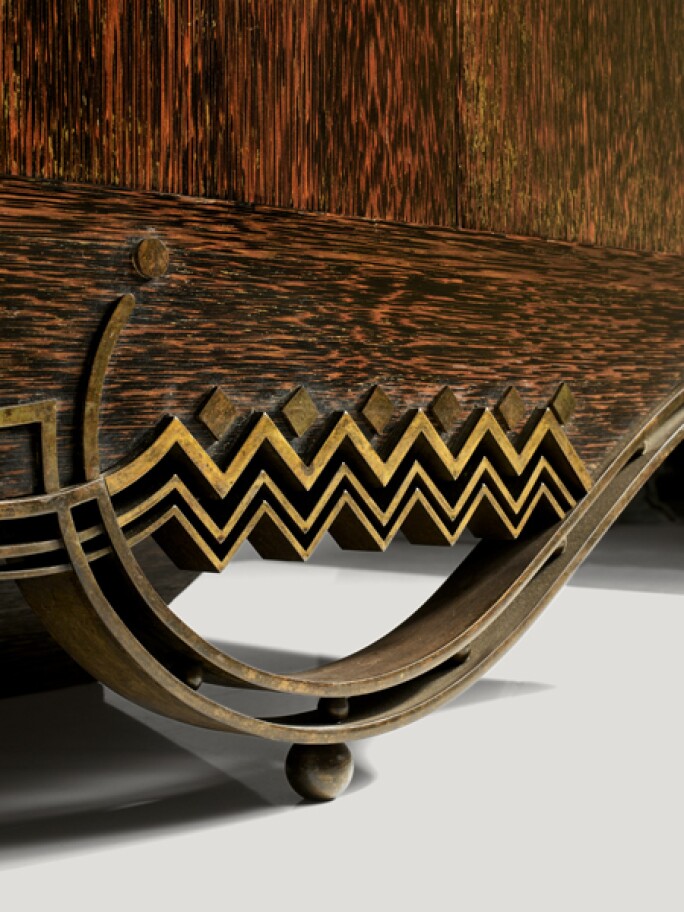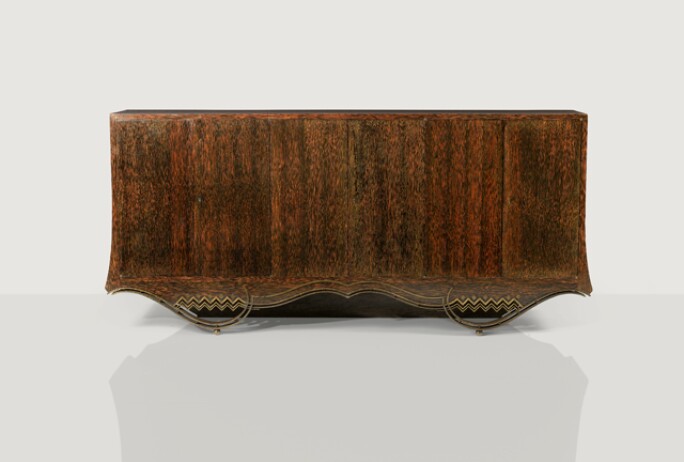Born in Naples in 1927, Mario Valentino began his career as a designer against the backdrop of post-war Italy. His father had made bespoke shoes for the Neapolitan aristocracy before the war and Valentino therefore grew up among the artisanal processes of leather craftsmanship, later earning himself the nickname ‘King of Leather’ for his studied mastery of the material. Over several decades, he amassed an unrivalled collection of fine art and 20th Century Design, including this elegant palmwood sideboard, which is offered in the upcoming Design sale in Paris on 3 May.
An innovator in design, Valentino intuitively responded to the dynamism of mid-century Europe and its demand for rich colours, voluptuous silhouettes and high, sculptural shoes. As European products began to enter the American market reinvigorated by the economic boost of the Marshall Plan, so too did Valentino’s designs captivate an international audience, with the particular, elegant cachet of quality conferred by the ‘Made In Italy’ label.
Along with Roger Vivier, Mario Valentino was one of the earliest exponents of the low-cut stiletto and a pioneer of the flat sandal, at one point scandalising the fashion world by creating a sandal made of coral. Praised by Diana Vreeland, Valentino’s deconstructed sandals were iconically photographed by a young Guy Bourdin for the cover of French Vogue in 1956, engaging a new wave of high-profile customers including Jackie Onassis, Elizabeth Taylor, Ava Gardner and Catherine Deneuve.
A storied designer and dedicated patron of the arts, Mario Valentino shaped a fashion empire from its beginnings as a local service for well-heeled Neapolitans into a global phenomenon and cultural legacy. From clothing collaborations with Paco Rabanne and Karl Lagerfeld to his work with iconic image-makers Richard Avedon and Helmut Newton, Valentino ranks among one of the most beloved designers of the twentieth century. Sotheby’s is delighted to present a selection of works from the Mario Valentino collection, offered in London in the Impressionist & Modern Art Evening and Day Sales on 19 and 20 June and in the Contemporary Art Evening and Day Sales on 26 and 27 June.
Among his contemporaries in the landscape of Italian fashion, Valentino counted the Marquis Emilio Pucci and Salvatore Ferragamo, both of whom were gaining ground in the European and American markets. The twin passions for art and fashion were felt keenly by this generation of young designers, whose chromatic sensibilities in the world of couture translated symbiotically into a devotion to Italian art and collecting. Valentino himself sponsored the restoration of hand-embroidered tapestries and sixteenth-century frescoes at the Neapolitan convent of Santa Chiara. He housed part of his collection in his apartment at the Cellamare Palace adorning rooms already filled with elegant 1920s and 30s furniture.
This collection featured works by Andy Warhol, who became a friend, Gino Severini, Giorgio de Chirico and Art Nouveau objects by René Lalique and Marius-Ernest Sabino. As was the custom among his peers, Valentino also filled his retail and manufacturing spaces with fine art and precious objects; the collection was to be experienced and felt not only by himself but by those living and working around him. The designer had developed a firm friendship with dealer and curator Lucio Amelio, who exhibited international contemporary artists at his gallery in Naples. His friendship with Amelio proved to be a seminal one, whose patronage of exhibitions at the gallery was key to transforming the city into a bastion of the avant-garde landscape of the 1980s.
The present sideboard by Eugène Printz, epitomises his style: the use of palmwood, one of his most recognisable wood, combined with the oxidised brass ornaments of the base and the silky sycamore veneer used for the inner parts, all together make of this sideboard an extremely refine and luxurious example of Printz at his best. It also reflect the high standard of craftsmanship used in France during the 30s where processes inherited by the XVIIIth century traditional cabinet making where originally and dynamically re-interpreted to appeal to the new trends of Art Déco.
CLICK HERE to view the full sale catalogue.





